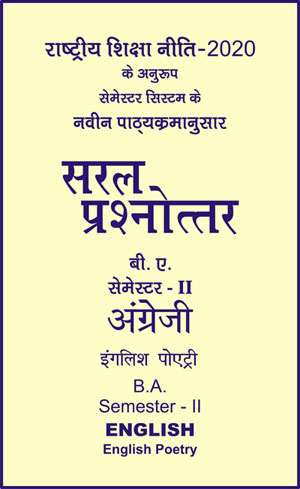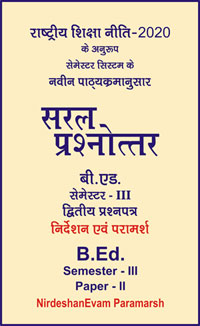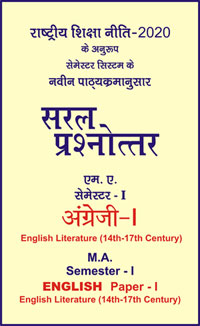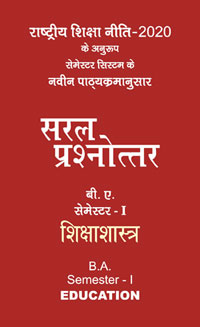|
बी ए - एम ए >> बीए सेमेस्टर-2 - अंग्रेजी - इंगलिश पोएट्री बीए सेमेस्टर-2 - अंग्रेजी - इंगलिश पोएट्रीसरल प्रश्नोत्तर समूह
|
|
|||||||
बीए सेमेस्टर-2 - अंग्रेजी - इंगलिश पोएट्री
Chapter - 4
"On His Blindness"
- John Milton
Life and Works of Milton
John Milton was the son of John Milton the editor and a composer of Milton. He was born in 1608, was educated at St. Paul's school and Christ's College Cambridge. He received his B.A. in 1629 and M.A. in 1632. While at Cambridge he wrote the poems on "The Death of Fair Infant,' and 'At a Vacation Exercise,' and some Latin elegies and epigrams, but he first struck a distinctive stately ode on the morning of Christ Nativity (1629), the fragmentary passion and the poem on Shakespeare (1630). After leaving Cambridge, Milton lived at Horton in Bucks with his father, reading the classics and preparing himself for his vacations as a poet, from 1632 to 1637. Here he composed 'L. Allegro' and '11 Penseroso' in 1632. In 1637 he wrote 'Hycidas'. During the twenty years that elapsed between this and his composition of the Paradise Lost, Milton wrote no poetry but the sonnets and some Latin and Italian pieces.
Milton married Mary Powell, daughter of royalist parents, probably in June 1642. Within six weeks he consented to her going home to her parents on condition that she returned. She did not do so, so perhaps for reasons connected with the out break of the civil war. Milton published in 1643 his pamphlet on the 'Doctrine and Discipline of Divorce, Which made him notorious. In 1644-45 he published three further pamphlet on divorce, his Tractate of Education and the Areopagitica on the liberty of the press were published. His wife rejoined him in 1645. After the execution of charles-I, he published the Tenure of Kings and Magistrates (1649) and was appointed Latin secretary to the newly formed council of state. In 1652, Milton become totally blind and his first wife died, leaving three daughters and in 1656, he married Catherine Woodcock, who died in 1658. He retained his post as Latin Secretary until the restoration. At the restoration he was arrested and fined, but released, he lost the greater part of his fortune. He returned to poetry and set about the composition of Paradise Lost, the first sketch of which can be dated as early as 1642. He married his third wife Elizabeth Minshall in 1662. The Paradise Lost is said by Aubrey to have been finished in 1663 but the agreement for copyright was not signed till 1667. 'Paradise Regained' and Semson Agonistes' were published together in 1671.
Of Milton's Latin poem's, the finest in the Epitaphiun Damonis, writters in 1639, on the death of his friend Charles Diadati while the address to mansus has great interest. The state poems that he wrote as Latin Secretary are mostly concemed with the routine work of the diplomacy, but include an interesting series of despatches on the expulsion of the protestant vaudoirs. The Latin prose writing include his De Doctrine's Christiana printed in 1825 which served as the occasion for Macauley's eassay on Milton. Milton died a quiet death in 1674.
Introduction of the Sonnet
'On His Blindness' was written in 1652, a few months after Milton's becoming totally blind. It appeared in the 1675 edition of his poems. The subject of the poem is strictly a personal one. The poet gives expression to his grief and doubts aroused in him because of his blindness. He laments his loss and asks himself whether he would be punished by God for not making use of his gift of poetry. He consoles himself with the idea that though his blindness has deprived him of actual service, the willingness of his heart to serve God would bring him credit. The sonnet is full of meekness and humility. It teaches resignation. The sonnet follows the Italian model. Its rhyme scheme is abba, a b ba, c d e, c d e. Its language is simple and touching and almost Viblical. It gives us the impression of sacredness and piety.
Main Points of the Sonnet -
(i) God has granted the poet the gift of poetry but inspite of his willingness he is unable to make any use of it because of his blindness.
(ii) The poet is afraid that God might punish him for not serving Him by means of his poetry.
(iii) The poet finds comfort in the thought that God judges us not by our actions but by the degree of our willingness in obeying His commands.
(iv) The best service of God consists in resigning ourselves to the will of God.
Substance of the Sonnet
When the poet thinks about his blindness, he becomes sad. He has hardly covered half the span of his life. The world is dark and gloomy to him. Still he wants to write poems and present a true account of his poetic genius to God. Who has bestained the gift on him. Patience consoles him by saying that God does not require return of His gifts. Those persons who bear all the sorrows and afflicitions of life without complaining, are His true devotees. The kingdom of God is great. Thousand of angles serve him. These persons who silently pray to God and wait for His commands, also serve Him. They are also His true devotees.
हिन्दी सारांश
जब कवि अपनी अन्धता के विषय में विचारता है, वह दुःखी हो जाता है। उसने अभी आधी उम्र ही व्यतीत की है। संसार उसके लिये अंधकारपूर्ण और निराशाजनक है। फिर भी वह कविता लिखना चाहता है और ईश्वर के सामने अपना सही विवरण प्रस्तुत करना चाहता है जिसने उसे यह भेंट दी थी। धैर्य उसे यह कहकर सांत्वना देता है कि ईश्वर को अपनी देन की वापसी नहीं चाहिये। वे लोग जो बिना किसी शिकायत के दुःखों को सहन करते हैं, वे उसके सच्चे भक्त हैं। ईश्वर का राज्य महान है। हजारों देवदूत उसकी सेवा करते हैं। जो उसकी प्रार्थना करते हैं और उसके आदेशों की प्रतीक्षा करते हैं, वे भी उसकी सेवा करते हैं। जो उनके सच्चे भक्त होते हैं।
|
|||||
- Chapter - 1 Forms of Poetry & Stanza Forms
- Objective Type Questions
- Answers
- Chapter - 2 Poetic Device
- Objective Type Questions
- Answers
- Chapter - 3 "Let Me Not to the Marriage of True Minds" (Sonnet No. 116)
- Objective Type Questions
- Answers
- Chapter - 4 "On His Blindness"
- Objective Type Questions
- Answers
- Chapter - 5 "Present in Absence"
- Objective Type Questions
- Answers
- Chapter - 6 "Essay on Man”
- Objective Type Questions
- Answers
- Chapter - 7 "Elegy Written in a Country Churchyard”
- Objective Type Questions
- Answers
- Chapter - 8 "The World is Too Much with Us"
- Objective Type Questions
- Answers
- Chapter - 9 "Ode on a Grecian Urn"
- Objective Type Questions
- Answers
- Chapter - 10 "Break, Break, Break"
- Objective Type Questions
- Answers
- Chapter - 11 "How Do I Love Thee?"
- Objective Type Questions
- Answers
- Chapter - 12 "Dover Beach"
- Objective Type Questions
- Answers
- Chapter - 13 "My Last Duchess'
- Objective Type Questions
- Answers
- Chapter - 14 "The Love Song of J. Alfred Prufrock"
- Objective Type Questions
- Answers
- Chapter - 15 "The Lake Isle of Innisfree"
- Objective Type Questions
- Answers
- Chapter - 16 "Church Going"
- Objective Type Questions
- Answers
- Chapter - 17 Rhetoric and Prosody - Practical Criticism
- Objective Type Questions
- Answers

 i
i 










